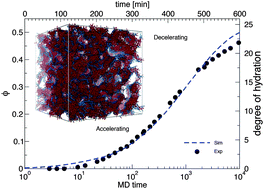Controlling local packing and growth in calcium–silicate–hydrate gels
Abstract
We investigate the development of gels under out-of-equilibrium conditions, such as calcium–silicate–hydrate (C–S–H) gels that form during cement hydration and are the major factor responsible for cement mechanical strength. We propose a new model and numerical approach to follow the gel formation upon precipitation and aggregation of nano-scale colloidal hydrates, whose effective interactions are consistent with forces measured in experiments at fixed lime concentrations. We use Grand Canonical Monte Carlo to mimic precipitation events during Molecular Dynamics simulations, with their rate corresponding to the hydrate production rate set by the chemical environment. Our results display hydrate precipitation curves that indeed reproduce the acceleration and deceleration regime typically observed in experiments and we are able to correctly capture the effect of lime concentration on the hydration kinetics and the gel morphology. Our analysis of the evolution of the gel morphology indicates that the acceleration is related to the formation of an optimal local crystalline packing that allows for large, elongated aggregates to grow and that is controlled by the underlying thermodynamics. The defects produced during precipitation favor branching and gelation that end up controlling the deceleration. The effects on the mechanical properties of C–S–H gels are also discussed.


 Please wait while we load your content...
Please wait while we load your content...